Jean Robert Alexis
Jerry Reginald Chery aka Twokèt
Ebony Hickey
Louis Kervens aka Bakari
Romel Jean Pierre
Michel Lafleur
David Sainté
AUSTRALIA
Ebony Hickey
AUSTRIA
Richard Zeiss
BARBADOS
Elizabeth Woodroffe
BELGIUM
Tom Bogaert
CANADA
Jared Epp
DENMARK
Tone Olaf Nielsen
FRANCE
Maccha Kasparian
Nelta Kasparian
Mehryl Ferri Levisse
Justine Shivay
Mats Stromberg
GERMANY
Nanne Buurman
Chaveli Sifre
GUADELOUPE
Stéphanie Melyon-Reinette ANAMNESIS-K
ITALY
Tom Bogaert
MOROCCO
Mehryl Ferri Levisse
NEW CALEDONIA
Justine Shivay
PUERTO RICO
Chaveli Sifre
SWEDEN
Lisa Janbell
Camilla Sivam
Runo Lagomarsino
UNITED KINGDOM
Elliot Evans
Leah Gordon
Charlotte Hammond
Holly Hunter
Ophelia dos Santos
Richard Zeiss
Elizabeth Woodroffe
UNITED STATES
Zion Estrada
Dominique Petit Frere
Romel Jean Pierre
Bryan Pettigrew
David Sainté
Mats Stromberg
Jean Robert Alexis (HT)
LA PORTE DE VODOU N'GANGA
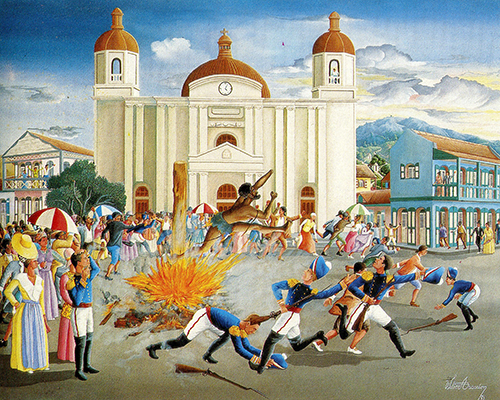
François Mackandal, who was a maroon slave, a voodoo priest was the first major figure in the rebellion that was going to lead to the great Haitian revolution. It was the Lwa who provided Mackandal with the necessary energy, while revealing to him the secrets of the nature, to lead his fight and trigger the revolt. From my point of view, the door is of deep symbolism. In Haitian practice, when you knock on someone's door, it last does not ask “who knocks?”, but “honor!” and the knocker answers "respect". Without wishing to be naively utopian, I think that this humanity is possible. This door also symbolizes any device in place to create borders: races, social classes, etc. I propose an installation comprising incantatory drawings of voodoo on a door. All the artistic production will be made with objects that I will have found at random. I will opt for an interactive approach, relying on dialogue.
François Mackandal, qui était un esclave marron, un prêtre du vodou a ete la première grande figure de la rébellion qui allait déboucher sur la grande révolution haïtienne. Ce sont les Lwa qui ont fourni à Mackandal l’énergie nécessaire, tout en lui dévoilant les secrets de la nature, pour mener son combat et déclencher la révolte. De mon point de vue, la porte est d’un symbolisme profond. Dans la pratique haïtienne, quand on frappe à la porte de quelqu’un, ce dernier ne demande pas «qui frappe?», mais «honneur!» et celui qui frappe répond « respect ».Sans vouloir être naïvement utopiste, je pense que cette humanité est possible. Cette porte symbolise également tout dispositif en place pour créer de frontières : races, classes sociales, etc. Je propose une installation comportant des dessins incantatoires du vodou sur une porte. Tout le corpus artistique sera produit avec des objets que j’aurai trouvé au hasard. Pour l’exposition et/ou la restitution, j’opterai pour une approche interactive, misant sur le dialogue.
Back to artist list
Nanne Buurman (DE)
HOUSE OF THE UNDEAD HAUNTING THE FUTURE

For the 8th Ghetto Biennale Nanne Buurman plans to follow up on the 'g/hosting the past' project that took place during documenta fifteen at the Atis Rezistans | Ghetto Biennale venue of St. Kunigundis to deal with the unspoken Nazi and Colonial histories haunting exhibitions such as documenta. Together with artists, researchers and students of the University of Cologne, the German capital of carnival, she will collaborate on a satellite of the Ghetto Biennale to take place during the carnival celebrations in Cologne in February 2024.
Back to artist list
Tom Bogaert (BE/IT) & Michel Lafleur (HT)
ANBA DLO

Lafleur & Bogaert’s project for the 8th Ghetto Biennale in Jacmel, Haiti, revolves around creating unique mask-like diving masks. Named 'Anba Dlo,' their project pays tribute to the ocean and Agwé, the lwa (ancestral spirit) who governs over the sea, fish, aquatic plants, as well as being the patron lwa of fishermen and sailors.
In the Afro-Haitian cosmology called Vodou, it is said that the departed rest 'anba dlo' (the Creole spelling of ‘En bas de l’eau,’ which in French means under the water) for a year and reside in Agwé's palace, as the sea represents the physical pathway back to Ginen, or a mythical African realm. This also symbolizes a transition into the spiritual realm of the lwa and the ancestors.
Lafleur & Bogaert’s inspiration comes from various sources, such as Jacmel's papier-mâché carnival masks, traditional African masks, and films like 'Le Grand Blue', the 'Snorkel Scene' from 'Mama Mia', and Maya Deren's footage of an elaborate sea ceremony dedicated to Agwé. In addition, ‘Anba Dlo’ addresses the call of the water, taking into consideration the horror of the transatlantic slave trade and the terrible prospect of an impending Haitian boat refugee crisis.
Collaborating closely with local artists and artisans, Lafleur & Bogaert will craft these scuba masks on-site repurposing snorkelling tourism remnants. These divine diving masks will then be effectively employed to explore the waters surrounding Jacmel. If all goes according to plan, Lafleur & Bogaert aim to document these underwater performances through photography and film.
Back to artist list
Jerry Reginald Chery aka Twokèt (HT)
ANCESTORS OF THE BATTLEFIELD
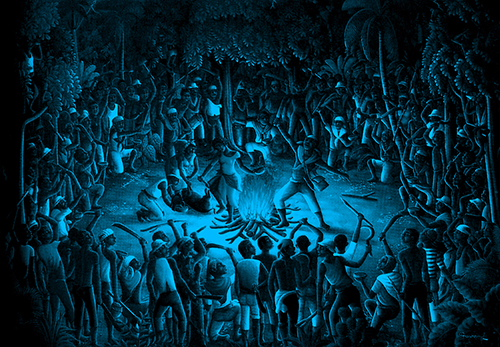
Antanke Atis Rezistans mw gn pwojè poum fè yn Bèl pyès ki reprezante zansèt yo ki mouri sou chan batay pou yo te libere esklav yo nan peyim mw Ayiti.Nou menm atis avèk geto byenyal nap montre mond lan kisa nou ka kreye. Viv Geto Byenal nan Jakmèl Viv Kanaval Zansèt yo Viv Ayiti !
Atis Twokèt atis rezistans!
As a Resistance Artist, I have a project to make a beautiful piece that represents the ancestors who died on the battlefield to free the slaves in my country Haiti. We artists with the ghetto biennial show the world what we can create. Live the Ghetto Biennale in Jakmèl Live the Carnival of the Ancestors Live Haiti!
Twokèt artist resistance artist!
Back to artist list
Jared Epp (CA) & Romel Jean Pierre (HT/US)
THE SILENT ARMY: RECLAIMING THE NAMELESS SOLDIERS OF HAITI'S REVOLUTION
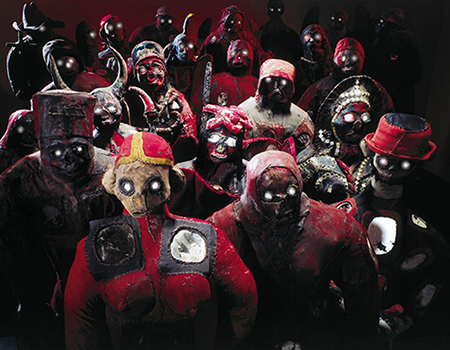
In a tribute to the overlooked heroes of the Haitian Revolution, "The Silent Army" aims to make the invisible visible. Merging art, history, and spirituality, the project will feature 21 life-sized statues, each representing a main 'nanchon' of Haitian Vodou. Crafted from recycled plastics from Jacmel’s beaches, these statues will be animated with soundbites—music, spoken word, and krik-krak tales—inviting an interactive engagement from visitors.
The exhibition will culminate in a symbolic sepulture ceremony, drawing inspiration from Vodou customs and China's Terracotta Army. A closing musical procession, incorporating elements of Haiti's rich funeral traditions, will escort the statues to their eternal resting place. "The Silent Army" aspires to be more than an art exhibit; it aims to immortalize the anonymous soldiers of Haiti's past, tying them even more to the universal narrative of human courage, cultural identity, and the everlasting quest for honour and remembrance.
@jaredepp
@jaredeppart
@RomelHaiti
@X.RomelAyiti
Back to artist list
Zion Estrada (US) & Dominique Petit Frere (US)
WILD GRASS
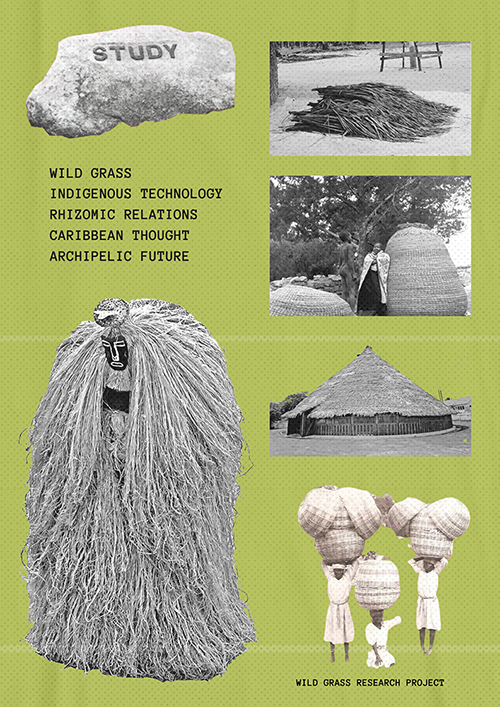
“Wild Grass” is an art and research project imagined by Zion Estrada & Dominique Petit-Frère, focused in the Caribbean, that complicates the ideas of territory, belonging & roots through the lens of wild grass, guided by the rhizomatic principles of Archipelagic Thought coined by Édouard Glissant.
What can we learn from the decentralized interconnected practices surrounding Kanaval, when we view them as rhizomatic practices? Wild Grass is an emergent art & research project, focused in the Caribbean, that explores territory, belonging & roots through the lens of wild grass. This perspective, informed by the rhizomatic resistance & disruptiveness of wild grass, locates us in the transgressive Kanaval processions in Jacmel.
We are proposing “They Left Us Messages In the Grass: An Imaginative Remembering of Submerged Haitian Histories Through Grass and Mask-making”. The project observes Kanaval and Jacmelian mask-making as a rhizomatic practice where customs & rituals take root & travel from underground back to the above through a process of fugitive remembering. This concept imagines sites across Jacmel as archivists; holding the stories
we seek to learn from.
Together in collaboration with local mask makers we want to co-journey through significant Kanaval locations to interview & archive the spatial and human knowledge. Our cogitation is that the spatiality of these Kanaval grounds hold codes, knowledge & histories that can be transformed into Kanaval attire. When the masks hold codes we can be “rooted” to the past through the grass materials & project the future with the mask form.
Due to ecocide & genocide, the concept of rootedness or being “from” somewhere has been destroyed. Owning to the fact of this reality, the project futures new ways for people within the diaspora to re-imagine rootedness through sacred “Rhizomic distance”. Like wild grass, we aim to re-experience the world as an experimental making of place, rather than a made place.
The project uses an emergent methodology centered in attunement. Guided by the principles of archipelagic thought, coined by Édouard Glissant, we value ecological mysticism, interrelationality & interdependence of all lands. Spatially, guided by the leadership of the local artists we will research & document sites of traditional Jacmelian mask-makers & Kanaval processions for both human art process & wild grass presence/history. The sonic methods include eco field recordings & oral history recordings.
In the material practice, we imagine the sacred grass material to be harvested & reworked into the traditional Kanaval papier-mâche practice with Jacmelian mask-making artisans to create a semi-permanent outdoor installation.
@zionestrada
@dominiquepetit_
Wild Grass Are.na
Back to artist list
Elliot Evans (GB) & Holly Hunter (GB)
KANAVAL OBSCURA / KAMERA OBSCURA
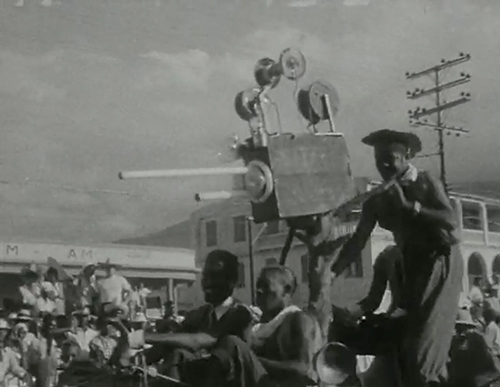
We propose to build a camera obscura in an accessible public space in Jacmel. A camera obscura is an ancient technology preceding the invention of the camera as we know it. It is a dark room, where a small hole or ‘lens’ in one wall creates the phenomena of the outside world projected upside down on the opposite wall. This will be a playful public site from which artists, locals and performers can participate in turning their world upside down.
The camera obscura, once set up, can operate as a dark room for developing paper negatives. We will run workshops in pin hole camera making and other camera-less photographic techniques. We will provide all materials and chemicals.
We acknowledge the deeply woven relationship between the camera and colonial exploitation in Haiti, and are very inspired by the ways in which local artists and carnival performers have parodied the fetishising lens of western film crews. We encourage and invite collaborators, performers and artists of all ages to use this space throughout the duration of the Biennale.
hollyhunter.biz
evans-elliot.com
Back to artist list
Leah Gordon (GB)
KANAVAL
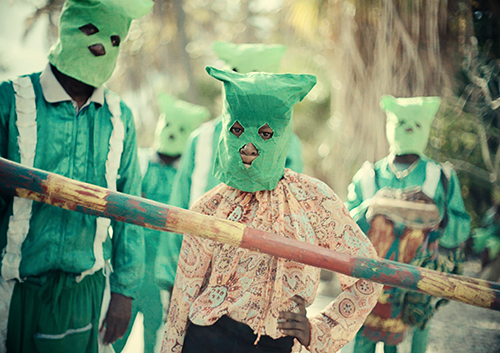
KANAVAL: A PEOPLE'S HISTORY OF HAITI IN SIX CHAPTERS will be screened in a public space in Jacmel alongside an exhibition of Leah Gordon's photographs re-presenting the local carnival from 1995 until 2023.
leahgordon.co.uk
@leah_gordon_1804
Back to artist list
Charlotte Hammond (GB) & Ophelia dos Santos (GB-CYM)
MADRAS PÈPÈ PLASTIK
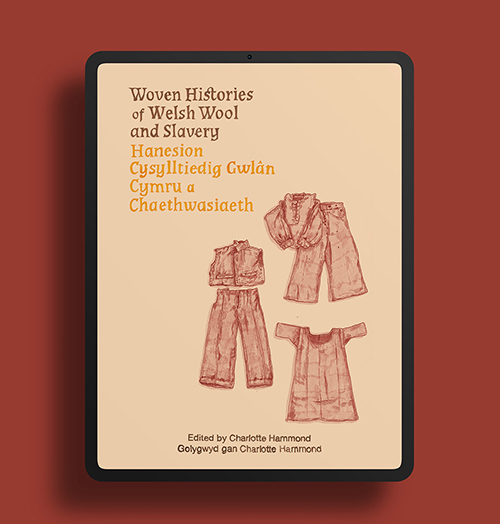
From the seventeenth century, madras cotton textiles produced along the Coromandel coast of southeast India and Gujurat were traded in large numbers by the British Royal African Company (1672), the East India Company (1600) and the French Compagnie des Indes (1664). Embedded within madras is a material history of global colonial trade, enslavement, and transnational movement across Asia, Africa, the Americas and Europe. Its layered warp and weft, checks and stripes once so popular in the Americas of the eighteenth century, have both signified and challenged the imposed racial and social classifications of coloniality. Manufactured initially for West African markets, the cloth travelled with enslaved individuals and was refashioned in plantation societies of the Caribbean to signal identity, belonging and resistance.
When madras appears in Haitian carnival today, it is often used in elaborate traditional costumes that reference the dress of free and enslaved women of colour of the colonial period: long, full skirts; tall cylindrical headwraps topped with straw hat, bamboo fans and jewelled necklaces and bracelets. For the 8th Ghetto Biennale in Jacmel I hope to work with a local textile artist to create a large drapery of woven madras textile from recycled plastic waste. The materials will include plastic weave sacks and plastic packaging used to ship material goods and imported food stuffs for sale in Haiti, and used cement bags commonly found in the port of Jacmel.
The madras pèpè uses a colonial design (plaid madras textile) to highlight the entanglements of historical and contemporary issues of plastic waste in Haiti as a major legacy of colonialism and repeated foreign interventions. I envisage the textile produced as a large carnivalesque veil (or mask) covering the entire head (referencing Egungun traditional masking). The heavy veil represents the overbearing burden of plastic waste and counters exoticising and eroticising colonial representations of local women via traditional Creole costume. There is potential for further collaboration with a local or visiting dancer/performer who may be interested in using the textile in a performance/song.
Back to artist list
Ebony Hickey (HT/AU)
UN-MASK, MY DNA
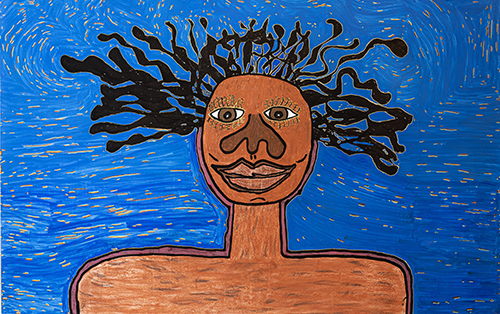
I want to offer myself to Haiti, expanding my art practice, I am a Haitian born baby year 1984 and taken from Haiti to Australia, letting my DNA re-knight in Haiti known, to my DNA makeup, but is complete unfamiliar to my being. What becomes, if there is unmasking, if evoked am I able to acknowledge the change. I am looking to explore what comes out creatively expanding my knowledge through my given right, home Haiti in a language that makes sense to me and had been used since the drawn of time ART.
ebonyhickey.com
@ebony.hickey.7
Back to artist list
Lisa Janbell (SE) & Camilla Sivam (SE)
A PRAYER TO THEM

The Stockholm-based performance duo and band Dos Oké, is composed of the dancers and choreographers Lisa Janbell and Camilla Sivam. Drawing on the power of sisterhood as twinship, their creative force, Dos Óke creates sacred electronic prayers through intuitive unified movements, music and chants.
Since 2011 Dos Óke has performed at various venues and events including Sónar-Barcelona, Way out West, Moderna Dans Teatern, Cinema Queer, Cirkus , Wip‐konsthall, Södra Teatern, Selva Studio, along with the video artist Johan Söderberg at Gagnef-festivalen/Skankaloss, Cats Wolfs and Bats, Göteborgs filmfestival, and many more. As well as at countless ceremonies and rituals.
At the Ghetto Biennale 2024 Dos Oké, Lisa Janbell & Camilla Sivam, will with deep respect for the spirits, vodouns, land and the Haitian people in Jacmel present an electronic acoustic prayer: A PRAYER TO THEM.
Together with local artists, such as video artists, ceremonial percussionists and an experimental music composer, Dos Oké will stage a ritual performance in the name of los muertos, the ancestors.
Back to artist list
Maccha Kasparian (FR) & Nelta Kasparian (UK)
BTM 'Behind The Mask'
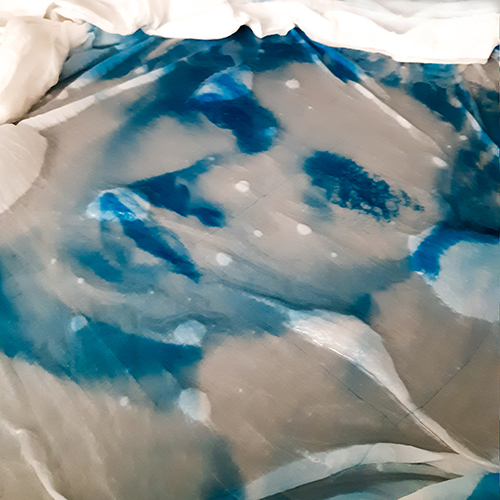
Our project, "BTM 'Behind The Mask' will be centered around the hidden stories and craft behind the papier mache masks of Jacmel. Through the medium of cyanotype photography, we intend to investigate the duality that arises from the practice of mask making and mask wearing in the context of Carnivals.
We see masks during Carnivals as instruments that allow individuals to temporarily explore alternative identities. We believe that they invoke ancestral spirits. Using the cyanotype photographic process, we'll illuminate the ancestral connections that breathe life into today’s mask makers.
@studioboissiere
@macchakasparian
@nelta.fr
Back to artist list
Louis Kervens aka Bakari (HT)
VEVE ABSTRE | ABSTRACT VEVE
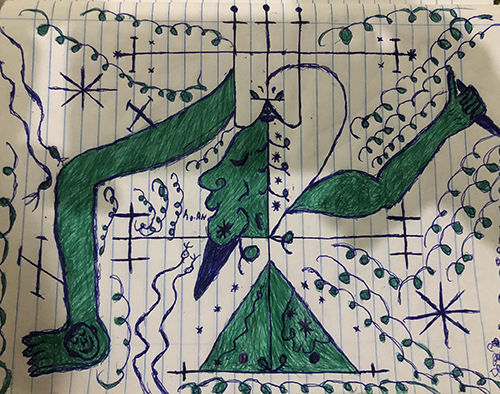
Projè mwen an se yon kolèktyon vèvè an defòmantyon abstrè mwen gen yon atis nan atelye mwen an ki ap patisipe avek mwen non Li se dave se yon élèv mwen.
My project is a collection of abstract deformations. I have an artist in my workshop called Dave who is participating with me, he is a student of mine.
Back to artist list
Runo Lagomarsino (SE) & Tone Olaf Nielsen (DK)
THE DAY THAT WAS DAY WAS NIGHT

In collaboration with members of Ti Moun Rezistans and Jacmel-based artists, Runo Lagomarsino & Tone Olaf Nielsen will in the project THE DAY THAT WAS DAY WAS NIGHT investigate how the sculptural language – materiality – can give forms to narratives capable of dealing with collective traumas in terms of resilience, remembrance and healing. The intension is to examine the possibilities (and limitations) of creating sites for (visual) thinking that can encompass non-hegemonic narratives. To look behind the image so to speak as a balance between forms of visuality and invisibility; a trust on what materials themselves can narrate, think, visualize and experience; a presence of performativity contained in material objects.
@toneolafnielsen
facebook.Runo.Lagomarsion
facebook.toneolafnielsen
Back to artist list
Mehryl Ferri Levisse (US)
WAPA LAGEBATAQA
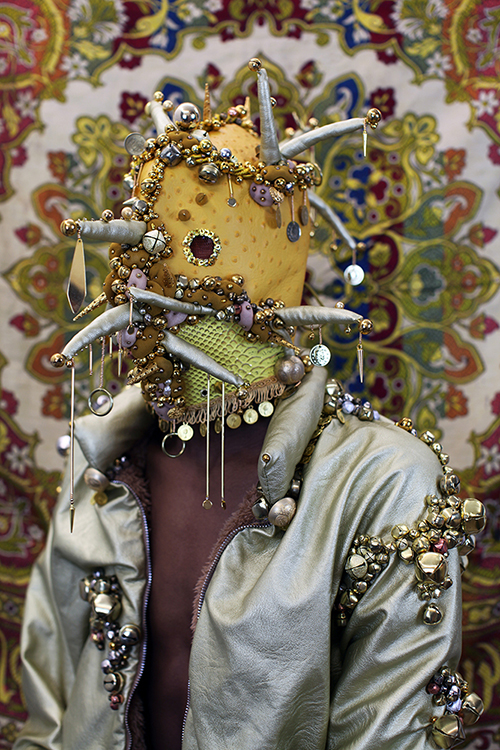
The project “Wapa Lagebataqa” is being implemented in Jacmel in collaboration with people from the local LGBTQ+ community. “Wapa Lagebataqa” explores the links that are woven between the LGBTQ+ community and Haitian Vodou. According to an article in the Canadien newspaper La presse published in 2019, Haitian Vodou is a safe space and refuge for lgbtq+ people in Haiti. Voodoo does not condemn lgbtq+ people because it is interested in souls and not actions. The project talks about the spaces we create when we come from a persecuted minority.
mehrylferrilevisse.com
@mehrylferrilevisse
Back to artist list
Stéphanie Melyon-Reinette ANAMNESIS-K (GP)
NOU, ZILI-OXHUM GWAN FAL
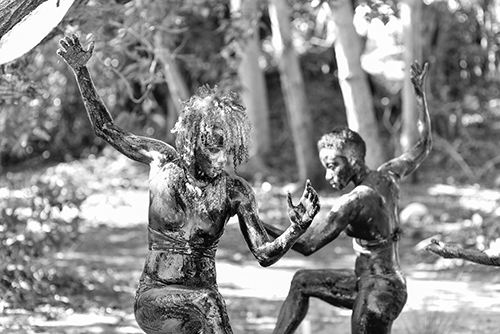
(Nous, Zili-Oxhum Grande bouche, Ventre sans fond, Grosse-Chatte-Gros-Fesses), femmes pléthoriques qui engorge toutes les énergies, toutes les intentions, toutes les femmes, convoque les voix muettes, mais émouvantes, sous la peau des humains post-coloniaux. Dans cette proposition, irriguée de diverses pratiques, cultures, croyances et créolités des artistes confluents ainsi que de leurs cultures, il y a le désir d'explorer les animismes présents et perdus, oubliés et niés, pour faire naître de nouvelles formes syncrétiques. Plaisir/désir enrichissent cette réflexion à la croisée des sens et de l'éther. Le mofwazaj , enfin, dans la tradition mas guadeloupéenne est la capacité du mas à se transformer en créature émancipatrice. Faisant écho et explorant la Dyonissia, réfléchissant à l'origine de l'orgasme féminin, les interprètes sont des entités-dieux/déesses-ancêtres à la gestuelle animale, évoluant sur un texte qui questionne l'origine du plaisir/désir féminin suivi d'une danse — cette proposition voudrait réunir des divinités afro-descendantes pour interroger l'animisme, le rapport au plaisir, le désir et la transformation : Erzulie, Oshun, Manman Dlo, mais aussi Baron Samdi, etc.
(We, Zili-Oxhum Big mouth, Bottomless belly, Big-Pussy-Big-Butt), plethoric women who congest all energies, all intentions, all women, summon the silent but moving voices under the skin of post-colonial humans. In this proposal, irrigated by various practices, cultures, beliefs and creolities of the confluent artists as well as their cultures, there is the desire to explore the animisms present and lost, forgotten and denied, to give birth to new syncretic forms. Pleasure/desire enrich this reflection at the crossroads of the senses and the ether. Mofwazaj, finally, in the Guadeloupean mas tradition is the capacity of the mas to transform itself into an emancipatory creature. Echoing and exploring Dyonissia, reflecting on the origin of the female orgasm, the performers are ancestor-gods/goddesses-entities with animal gestures, evolving on a text which questions the origin of female pleasure/desire followed by a dance — this proposal would like to bring together Afro-descendant deities to question animism, the relationship to pleasure, desire and transformation: Erzulie, Oshun, Manman Dlo, but also Baron Samdi, etc.
@anamnesisk
@stephreinette
we-are-pregnant-with-freedom.com
Back to artist list
Bryan Pettigrew (US)
BLOCKHEAD

My proposal is to create an Afro-Futuristic multimedia performance and art exhibition that honors the past with aspects of the future. The performance features my cryptic wandering character “Blockhead” who usually wears a wooden helmet created out of different objects. I really enjoy creating assemblage sculptures and will have them be a part of the suit as well as props and sculptures for the exhibition. Blockhead will explore Haiti and discover his connections to the ancestors as well as perform alongside them. I’d love to perform alongside fellow community artists who could play the ancestors.
Back to artist list
David Sainté (HT/US)
NOU MACHE LÈ SOLÈY KOUCHE
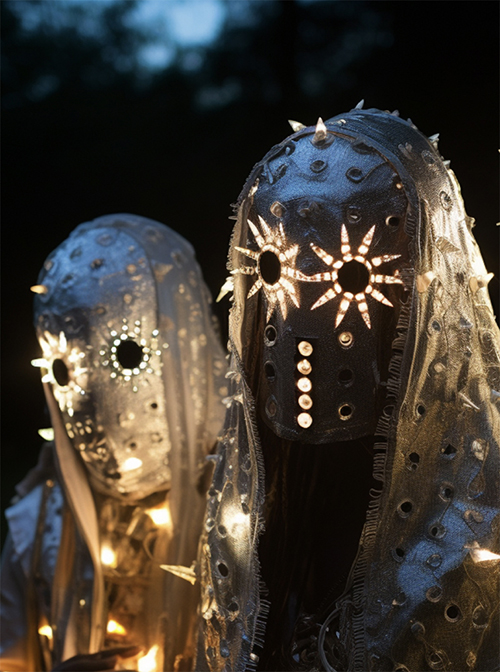
Intricately intertwining Jacmel's vibrant historical Kanaval heritage with a luminous vision of the future, melding the world of reflective metals and radiant lights with the traditional crafts of Kanaval mask making and metal art. Rooted in profound inspiration derived from dreams, childhood memories, spirituality and Afrofuturism.
@i.day.dream.in.summer
davidsainte.com
Back to artist list
Justine Shivay (FR/NC)
OFFERING TO THE JACMEL’S RIVER

For this 8th edition of the Ghetto Biennale: carnival of the ancestors, Shivay La Multiple proposes a procession culminating in an offering made to that primordial ancestral element, WATER, at the mouth of the Cosse de Jacmel. The "River", a political, economic, poetic and spiritual entity populated by auspicious, harmful or protective figures, takes on a metaphysical, mythical dimension that must be honored. Carnival is a moment of communication between worlds and beings, a ritual of purification to kill the demons of the year and allow the magical rebirth of nature and mankind. It is in this conception of carnival that he proposes this offering. The town's inhabitants will be invited to join the carnival procession and take part in the offerings. The offering will be a convivial and apotropaic moment to the glory of Jacmel's waters, the humans and non-humans that these waters shelter.
Back to artist list
Chaveli Sifre (PR/DE)
LUSTRAL ATTIRE
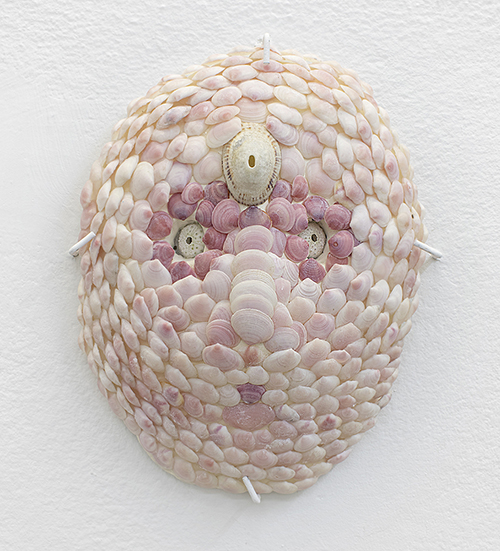
For ‘Kanaval Zanset’ I would like to crete a Lustral Attire that feeds from my practice of making masks with seashells from the beaches of my native Puerto Rico. However, for this project, I will incorporate seashells and other materials sourced from the beaches of Jacmal. A shell is already a mask, a protective layer that encases the softness of the flesh, they are a living symbol, not only of masks, but also of our own body and soul, our gros bon ange. The act of bending down to collect these seashells becomes a ritual in itself, symbolizing connection, integration, and acknowledgment. This repetitive gesture resonates with the act of kissing the soil, and honors the shores as a point of contact, a meeting of two planes, a portal into our shared histories. The attire evolves daily serving as a tangible record of the bonds formed. While the attire's construction is a daily endeavor involving collection and sewing, it culminates in a finale at night where the Lustral Attire is set aflame. This act mirrors the "año viejo" New Year's ritual in Puerto Rico, a tradition of burning clothes for good luck in the coming year, a ritual my grandfather faithfully observed. The meticulously crafted attire burns, akin to incense, with its smoke rising as a prayer from the sea, channeling our efforts into other dimensions.
@chavelisifre
chavelisifre.com
Back to artist list
Mats Stromberg (FR/US)
CARNIVAL OF SOULS
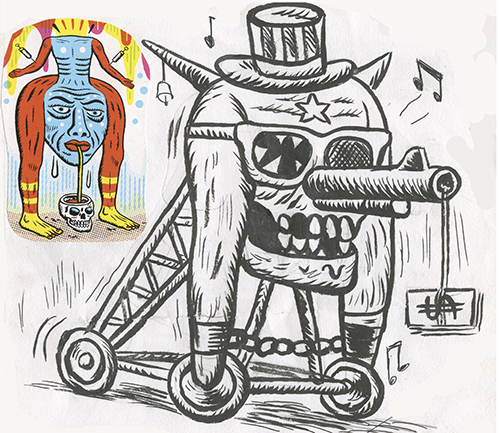
Create mobile sculpture on wheels made of some type of lightweight armature and papier-mache. A sort of Hybrid Carnival float/armored vehicle/trojan horse that protects and frightens. Referencing visually the dual tension the population possibly feels being targets of armed bandits as well as the police apparatus. Aesthetically inspired by a blend of Vodou Lwas and my personal grotesque cartoon creations.
@stinckermats
@X.MStrombergart
Back to artist list
Richard Zeiss (AT/GB)
MEDYATÈ
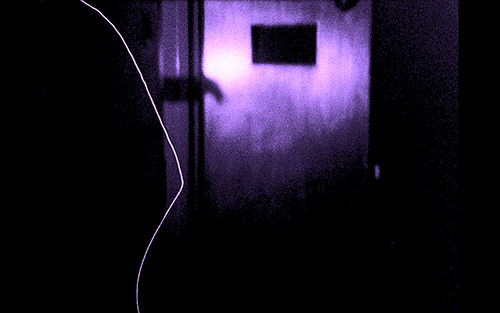
Inspired by the two opposite functions of the mask, i.e. on the one hand to shield/hide us and on the other hand to heighten our presence, I have found myself looking at the omnipresent prominence of binaries, particularly Life vs. Death in Voodoo culture. In doing so, I have come across the intriguing figure of Gede Nibo, a psychopomp who navigates the in-between of Life and Death – connecting, mediating, bridging. My project at the 2024 Ghetto Biennale is based on Gede Nibo’s ability to disregard the binary of Life and Death; Wake and Dream; Here and Over There.
For the Biennale, I will create hard-edge black and white paintings of significant size with very basic visual themes, mostly on the abstract end of the spectrum. I will also collaborate with a local artist to create a mask and carnival dress. The idea is to create a Gede Nibo character. This character – or a performer in mask and costume – will “activate” the paintings either in a designated space or in a procession on the street. Gede Nibo will basically be acting as intermediary between the aforementioned black and white paintings.
@richard_zeiss
@duckandrabbitprojects
richardzeiss.com
Back to artist list
Elizabeth Woodroffe (BB\GB)
GHETTO CUP | KÒP GETO
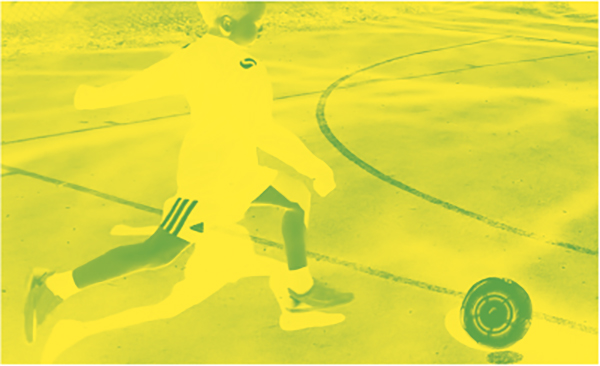
This project aims to focus on health and the strength in unity by working with the community to use their love of football to host a street football tournament called the ‘Ghetto Cup’. There will also be a competition for design proposals for the ‘Ghetto Cup Trophy’’ and a fee will be paid for the winning creation. Prizes are also being considered: food hampers for the ‘Ghetto Cup’ football tournament team entrants, and monetary prize for the tournament winners and runner ups. It is hoped the competition will be embraced by the wider community whether as a competitor, official or spectator etc and continued every year as a sporting event held yearly under the ‘Ghetto Cup’ title.
There are many sporting initiatives around the world created to inspire people who are disadvantaged to change their own lives.
Research shows, ‘Living in a disadvantaged area hampers young people’s development: area-based deprivation is strongly related to higher crime, poorer educational achievement, health problems and high levels of disability. These factors have a knock-on effect on the local environment and community spirit, with residents in poor areas experiencing roughly four times more social and environmental problems than residents in more affluent areas. Sport and outdoor physical activity can have a positive impact on young people’s lives, yet youngsters living in disadvantaged areas face many barriers to participation.’ Child Poverty Action Group.
CPAG SPORT & POVERTY REPORT.PDF
The Ghetto Cup aims to address the negative effects that social exclusion has on health and well-being, and raise awareness to tackle some of the top causes of death in Haiti, which include:
• lschemic heart disease.
• Stroke
• Lower respiratory infections.
• Neo-natal disorders.
• Diabetes